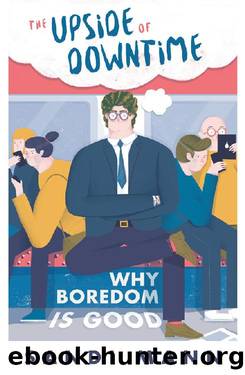The Science of Boredom: Why Boredom Is Good by Sandi Mann

Author:Sandi Mann [Mann, Sandi]
Language: eng
Format: epub
Tags: Cognitive Neuroscience, Emotions, Happiness, Mental Health, Non-Fiction, Personal Growth, Personality, Psychology, Self-Help
ISBN: 9781472136008
Google: 3fUqCgAAQBAJ
Amazon: 7111580656
Publisher: Hachette UK
Published: 2016-03-22T00:00:00+00:00
A Revolution in the Classroom
To combat pupil and student boredom then, we need a revolution in the way we view teaching. Whilst we should stop over-stimulating kids, we cannot (or indeed should not) turn the clock back to the days of the chalk and talk. Instead we need to look for new solutions that do not depend on what Professor Michael Fullan and his colleague, Maria Langworthy, call ‘pre-packaged, depersonalised learning experiences’.16 They recommend new ways of learning, such as students tutoring each other (peer instruction) and teachers working with students to create individually tailored knowledge. Teachers thus become partners in the learning process, which encourages students to take responsibility for their own learning journey. This would also challenge the issues of constraint and lack of power or control that pupils currently have over their learning, which some researchers believe contributes to their levels of boredom.11
Other researchers emphasise the need to raise levels of meaningfulness for students and ensuring a good match between ability and challenge. Because this can be hard to do, developing students’ ability to modify their own tasks and learning can give them the control to do this themselves.46 Control of their own learning experience is thus key to students being motivated to learn and develop themselves.
Within higher education the traditional concept of the ‘lecture’ and ‘lecturer’ has almost certainly had its day. The ‘sage on a stage’ approach is considered by many as not only boring, but ineffectual too; undergraduate students in classes with traditional stand-and-deliver lectures are 1.5 times more likely to fail than students in classes employing more stimulating, so-called active learning methods.47 The traditional lecture, relatively unchanged since the Middle Ages, is being rendered obsolete, partly because students’ brains are being rewired by their access to digital media, portable electronics and games.48 Students (and indeed school pupils) are also used to being able to access information at their own pace, when they want it, to pause or rewind or simply watch it again. Sitting still for up to two hours in a one-off passive opportunity no longer resonates with the rest of their lives. However, attempts to turn to what are considered ‘active’ methods, such as lab and computer classes, should be approached with caution, as my own findings suggest. Other techniques, such as using hand-held clickers, online interactive sessions, podcasts and peer instruction, can help transform passive into active learning.
Of course, the fact that pupils and students need such engagement is a product of society’s over-stimulated making. If we did not over-stimulate our kids from birth, we might not now find ourselves in the uncomfortable position of looking for increasingly exciting ways to engage and entertain students. Indeed, as a university lecturer myself, my efforts to engage with jokes, witty anecdotes, funny YouTube clips and chat show-style audience interaction mean that I prefer to refer to myself as a ‘Lecturetainer’ – delivering performances rather than lectures. Unless we stem the tide of novelty and sensation-seeking expectation, I fear the need to entertain will overtake the need to educate.
Download
This site does not store any files on its server. We only index and link to content provided by other sites. Please contact the content providers to delete copyright contents if any and email us, we'll remove relevant links or contents immediately.
The Science of Rapid Skill Acquisition by Peter Hollins(639)
Memory Builders by Frank MD Minirth(506)
Quantum Memory Power by Dominic O'Brien(492)
Mind Games by Neville Southall(479)
How to Improve Your Memory and Remember Anything: Flash Cards, Memory Palaces, Mnemonics (50+ Powerful Hacks for Amazing Memory Improvement) (The Learning Development Book Series 7) by John Connelly(431)
The Victorious Mind: How To Master Memory, Meditation and Mental Well-Being by Anthony Metivier(403)
The Science of Boredom: Why Boredom Is Good by Sandi Mann(390)
Brain Improvement: Access the Best Accelerated Learning Strategies to Declutter Your Mind, Be More Productive, Optimize Your Brain Capabilities and Unleash Your Unlimited Memory Power by Dr. Kevin Carol Miyake(349)
The Super Memory: 3 Memory Books in 1: Photographic Memory, Memory Training and Memory Improvement - How to Increase Memory and Brain Power (Upgrade Yourself) by Zeloni Magelli Edoardo(349)
Memory Improvement Book - The Mnemonics: Mind and Memory Improvement for Adults (The Active and Effective Leaders 2) by Andrew Kite(325)
Mental Focus and Brain Games For Memory Improvement by Speedy Publishing(289)
Summary of Moonwalking with Einstein by Instaread(285)
10000 Word Scramble Puzzles to Improve Your IQ (IQ BOOST PUZZLES) by Kalman Toth M.A. M.PHIL(273)
